A tale in three screen shots.



Everything I used to bore people on newsgroups and mailing lists with, now in one inconvenient place.
A tale in three screen shots.



I went out for a paddle today, and had both my Forerunner 920XT and my Fenix 6X on my foot strap, and both set up to “Race an Activity” with the same 10km activity selected. The course I was racing had 57:08.3 as the base time. I had my GoPro so I could grab some shots of both screens. I am doing this because I can’t for the life of me figure out what some of the fields are on the Fenix. I know what fields I need on the 920XT, but the equivalent fields on the Fenix are either in different places, or they show utterly insane values.
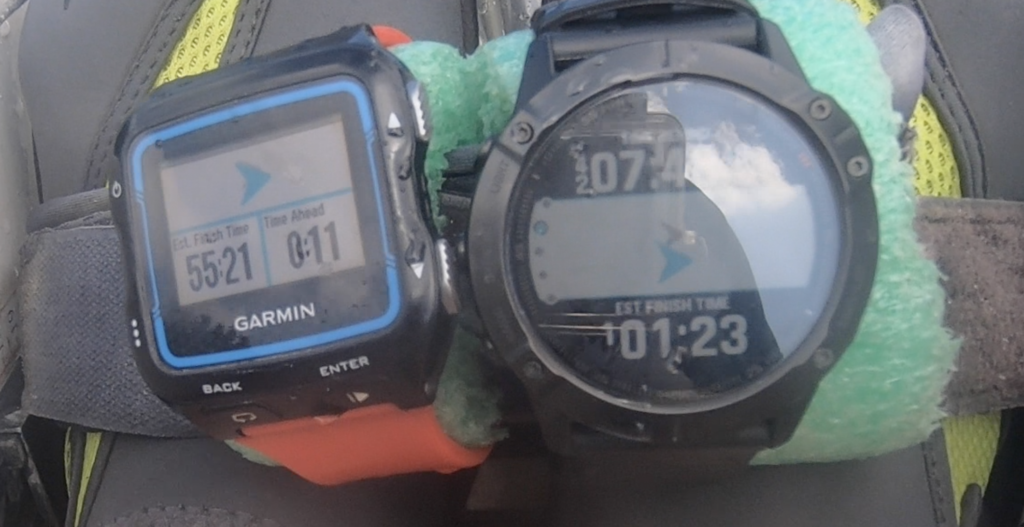
This picture is quite early on in the paddle. The 920XT is showing a Estimated Finish Time of 55:21, and Time Ahead of 0:11. So it thinks I’m going 11 seconds faster than the activity I’m racing. Since the difference between the target time of 57:08.3 and the estimated finish time of 55:31 is more than 11 seconds, I assume it means I’m 11 seconds ahead right now, but if I keep it up I’ll finish in 55:21. On the Fenix side, the Estimated Finish Time is 1:01:23. I have no idea why it thinks I’m 6 minutes slower than the 920XT. But here’s the insane part: The Time Behind is showing 42:07:48. WHERE THE FUCK IS THAT 42 HOURS COMING FROM!!! Even if the 42 represents something other than hours, if the time behind is 7:42, I’m trying to figure out what that mathematically relates to, because the estimated finish time is only 4:14 behind the goal time, not 7:42.
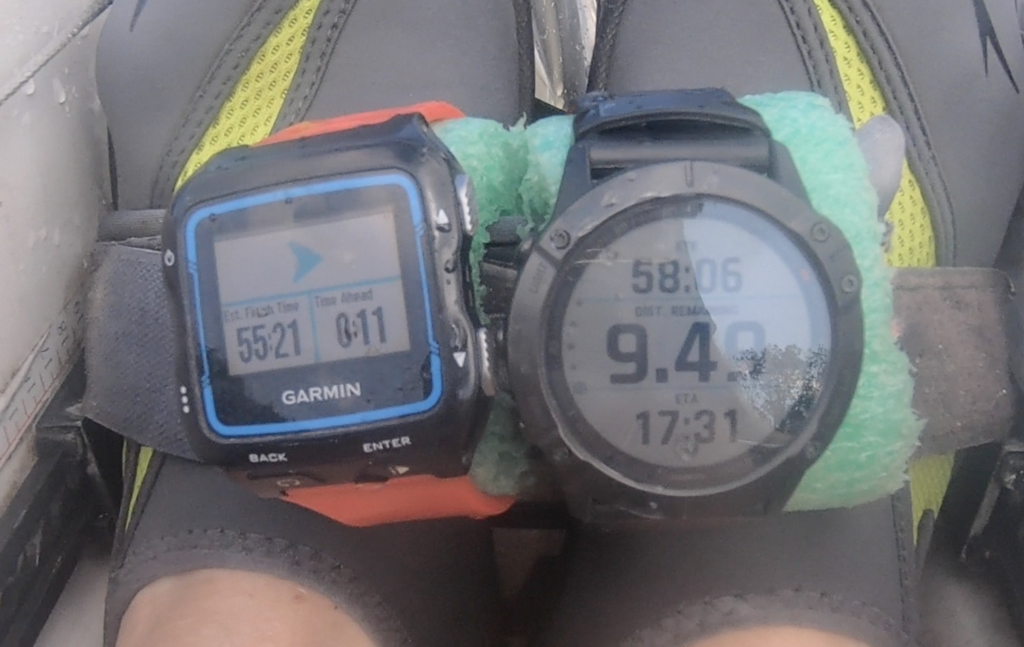
Another screen shot around the same time. The top one is labelled “ETE”, I think that’s time remaining. The middle one is distance remaining (9.49 km, so about 500 meters into the “race”). I’m not sure, but I think the bottom one is actually an estimate of the clock time when I’m expected to finish.
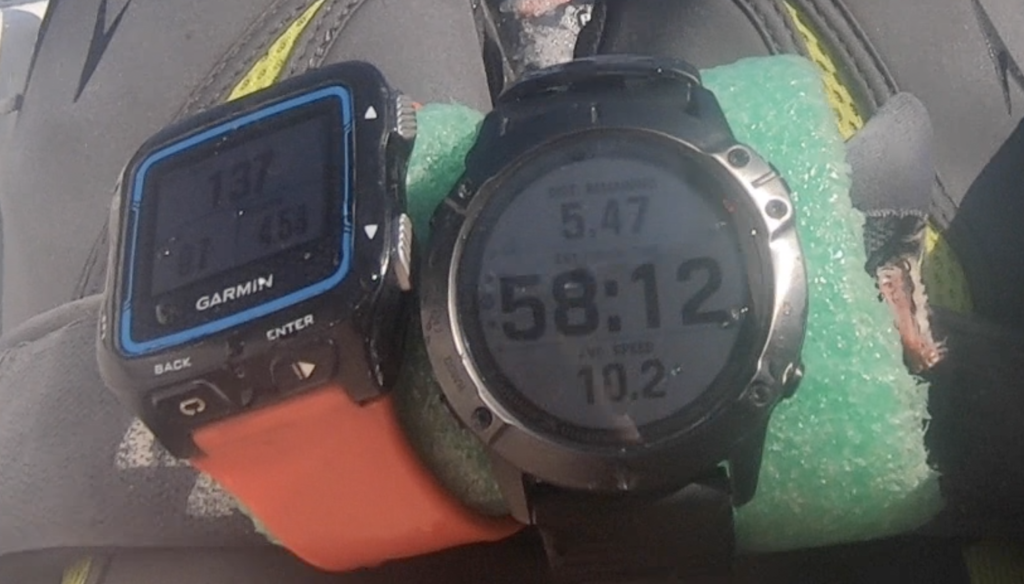
This is further along. I assume the prominent number in the middle is the estimated total time? The top one is distance remaining (5.47 km). That syncs up nicely with the 920XT saying I’ve completed 4.53 km.
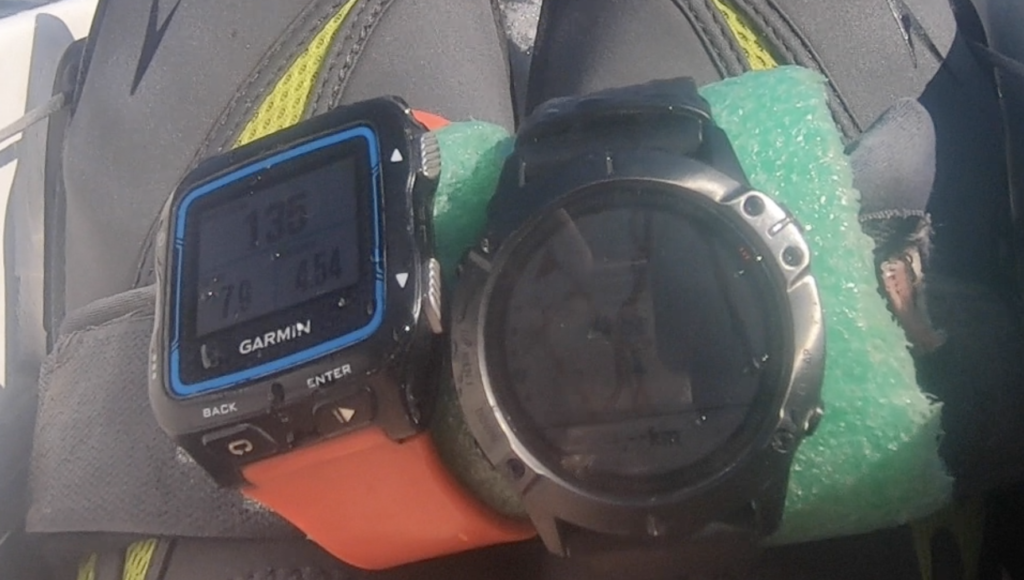
This is seconds after the previous one. The Fenix is showing an utterly useless map. If there’s a way to zoom this in so it would be more useful, I haven’t discovered it.
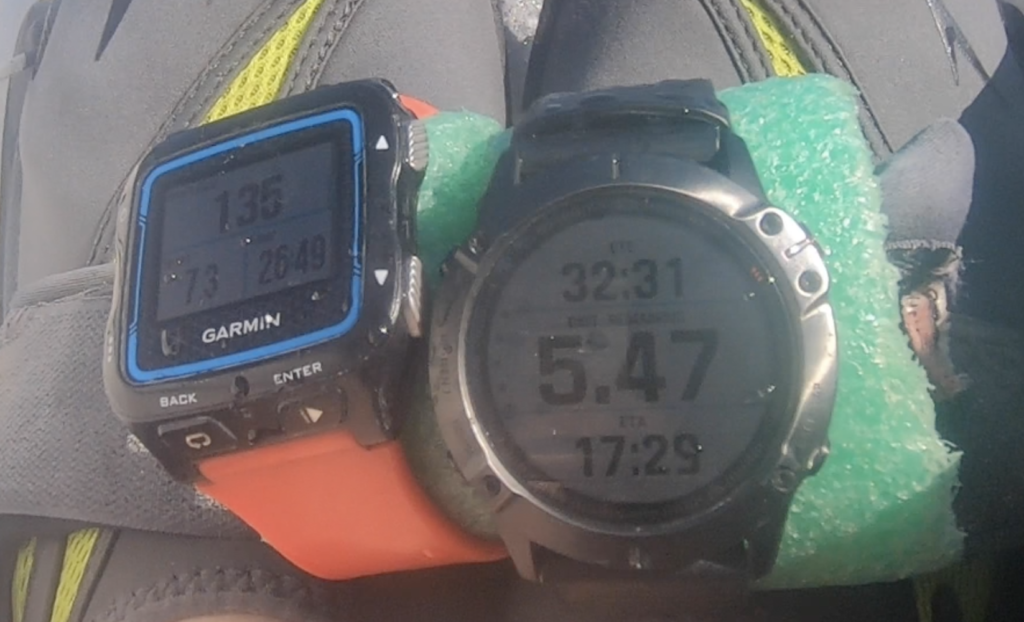
And a few seconds later. The Fenix is showing the same distance remaining, although this time in the prominent middle position. The top field is, as I mentioned in the second screen shot, apparently the estimated time to completion. The bottom one is the estimated clock time at completion. No idea why I’d want to know that.
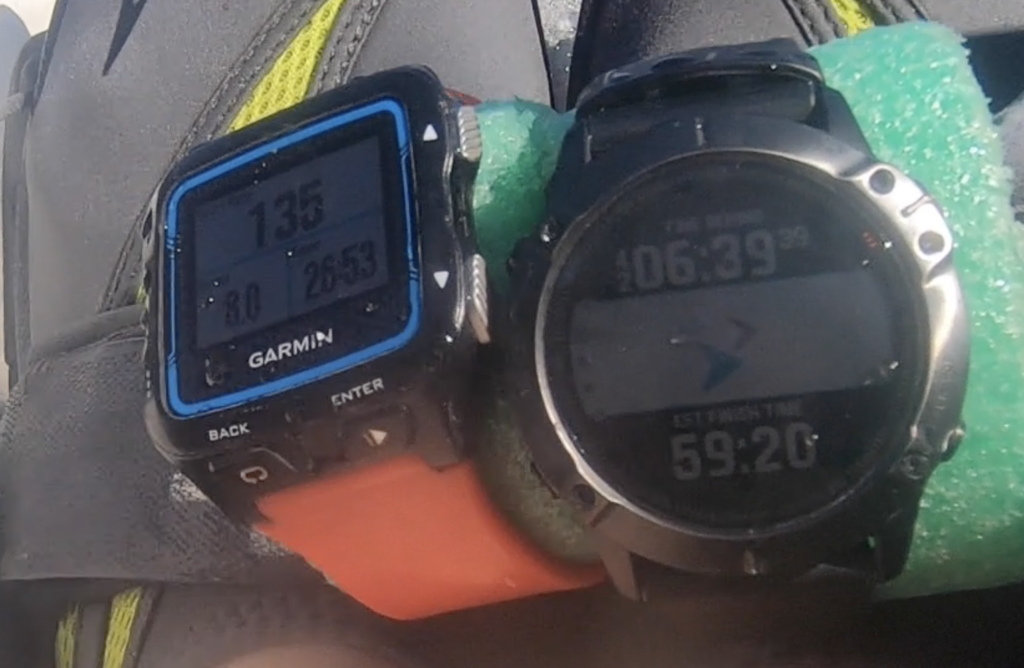
Here’s that baffling “Time Behind” again, still with the strange “42”. The estimated finish time at the bottom of 59:20 lines up OK with the 58:12 earlier in this second set of pictures because I had to stop paddling to take these so I’m getting slower with each shot. But again, even ignoring the “42” in the top field doesn’t make sense, because again, 59:20 is 2:11 slower than the goal time, not 6:39.
I wish there was some documentation on what these fields were, and I wish there was a way to customize them.
Early this year (or possibly, it’s hard to tell the flow of time, but it was “pre-COVID”), I saw a new 360 degree camera called the Insta360 ONE R. I was really interested because I’ve been thinking that a 360 degree camera might be better for my kayak videos that the split screen that I currently use (at least, what I use in the rare occasions when both cameras work). I could either publish as a 360 video or crop it to a flat but looking at what might be interesting right now (like the kayaker sneaking up behind me or the C-2 I’m about to take a rest behind).
And there are three reasons why I started thinking about this now with this camera when I hadn’t with previous 360 degree cameras:
For various reasons, GoPro has always seemed to target about a 70-80 minute battery life. And GoPro’s support page freely admits that they don’t care that the GoPro Hero 7 and Hero 8 will overheat and shut down long before you hit the 70 minutes if you’re trying to use the full advertised resolution and frame rate on a summer day. I get it, I guess, their target market are guys with RedBull sponsorships shooting 5-10 minute ski or surf or mountain bike runs, not me.
The ONE R listed a similar battery life (of course, no indication of whether they have a similar overheating problem), but they also listed a “boosted battery base” as an option that was coming soon. The “boosted battery base” would double the number of milliAmp-hours, theoretically giving you twice the battery life. But it wasn’t out, so I just bided my time.
Well, the Boosted Battery Base is now out. And to my massive disappointment, they have the following warning on the order page:
ONE R is not waterproof or designed for extreme action shooting when assembled with the Boosted Battery Base.
https://store.insta360.com/product/one_r_battery
I kind of don’t want to buy $500 for a camera if it’s going to be ruined if I tip over. That doesn’t often happen in a flat water race, but I have been pretty soaked by rain. And once would be enough.
When last I spoke about the 6X, I mentioned that they’d updated the firmware which vaulted the GPS performance from “utterly crap, I’d rather use a sextant” to “acceptable, but not as good as the 920XT”. Nothing has changed on that front. But I want to mention a few other things:
2. Garmin VIRB Edit, the software than I use for putting overlays on my videos doesn’t automatically pick up activities from my Fenix when it’s plugged into the computer the way it did with all my previous Forerunners (actually, I’m not sure if it did with the Forerunner 305, but definitely with the 310XT, the 910Xt and the 920XT). Instead I have to download the FIT file from Garmin Connect and upload it manually to Garmin VIRB Edit, which is annoying.
3. The Fenix 6 is utterly, 100% completely crap at reconnecting to the phone after they’ve been apart for any length of time. I charge my phone overnight in my office, but don’t take off the watch. In the morning, the 920XT would reconnect 99.9% of the time without any sort of intervention on my part. Just about every day, I will suddenly realize I’m not getting any notifications on my watch and go into the bluetooth menu on the phone to reconnect the Fenix. Today it disconnected while both the watch and the phone were on my surfski, less than 2 feet apart. My activity uploaded to Garmin Connect when I manually reconnected them afterwards, but for some reason it didn’t go to Strava. With the 920Xt, I was used to getting three notifications while I’m carrying my boat back to the car from the water – first one telling me the activity is on Garmin Connect, second one telling me it is on Strava, and third one telling me it is on Relive. I get that with the Fenix 6 more often than not, but certainly not with the certainty I would get it when using the 920XT. I may have to record a video to demonstrate how bad this is, since as I was writing this I realized my phone was in the other room, and when I went to pick it up it didn’t automatically reconnect to my Fenix.
Garmin replied to my support ticket to say that they were working on a patch to fix my problem and they’d inform me when it was ready. Then yesterday when I plugged my Fenix into the computer it did install an update, but I wasn’t sure if it was “the one” because they didn’t inform me. I decided to take both the Fenix 6X and the Forerunner 920Xt out on the canal to make another comparison.
My impression while paddling is that I didn’t see any ridiculous speeds this time, but the Fenix was reading a little higher than the 920Xt much of the time. Also, by the middle of the paddle the Fenix had the distance about 20 meters further, and by the time I finished it was nearly 40 meters.
I threw both FIT files into DC Rainmaker’s Analyze tool and found a few things.
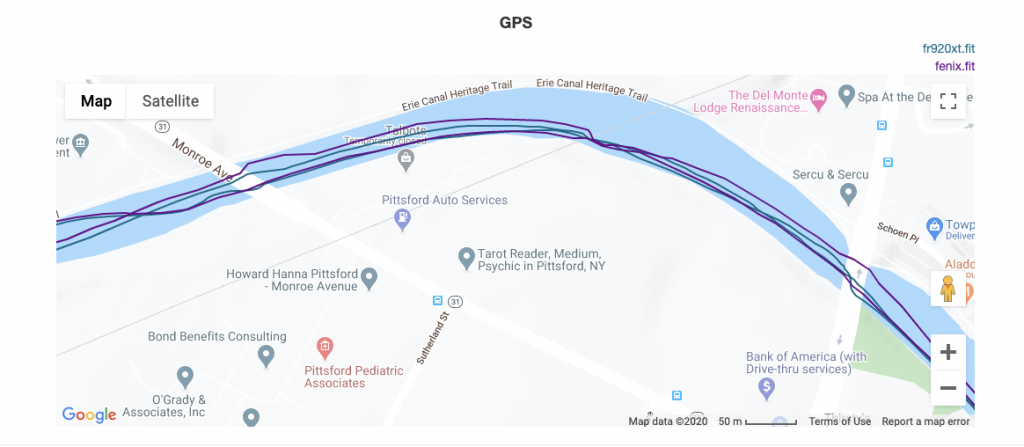
The first thing you see is that both tracks go a bit wonky around these bridges (and others not shown here). The purple line is the Fenix, and the blue line is the 920Xt. When I paddle downstream I tend to stick towards the middle of the canal (the upper lines) and when I return I tend to hug the inner shore. I can assure you I didn’t make a sudden jog to the left bank at Monroe Avenue as shown in the upper Fenix track or a sudden jog to the right shore as shown on both tracks. Same with the bridge at Schoen Place – the Fenix track shows me way too far north and the 920Xt track shows me making a sudden jog to the south, neither of which are correct. Overall the 920Xt seems to do a better job of showing my actual track, but the Fenix isn’t terrible.

Overall, it looks like the Fenix speed has been more aggressively smoothed, or maybe it’s not sampled as often. There’s a weird peak at the 16 minute mark where the 920Xt is showing 10.1 km/hr and the Fenix is showing 12.6, but otherwise they’re close. And not surprisingly, the spike occurs while passing under another bridge, State Street, which is also a steel bridge with big trusses.

When I zoom in you can see that the 920Xt speed is changing much more frequently than the Fenix. Come to think of it, I remember setting my 920Xt to sample every second – that might be something I need to do for the Fenix as well. You see a similar smoothing effect (or lack of sampling frequency effect) on heart rate even though they’re both paired to the same Wahoo TIKR heart rate strap.
One thing everybody should know about GPS watches is that their altitude information is terrible. And these two watches are terrible but different.

The Fenix is consistently higher elevation that the 920Xt, but with similar shape of ups and downs (on a practically flat canal). Only 3 or 4 meters elevation difference between them most of the time. I can’t find any obvious cause for the weird dip at around the 33 minute mark on the 920Xt as I’m nowhere near any bridges nor am I particularly close to the concrete walls of the “Washing Machine”. But that’s ok, I usually remember to click “Elevation corrections” on Garmin Connect and Strava after it’s uploaded. I think what they do is correct your elevation to what a digital elevation map says your elevation should be at each location point.
At this point I’m just about ready to declare myself ready to use the Fenix for normal paddling. I’ll do a few more head to head tests first, though.